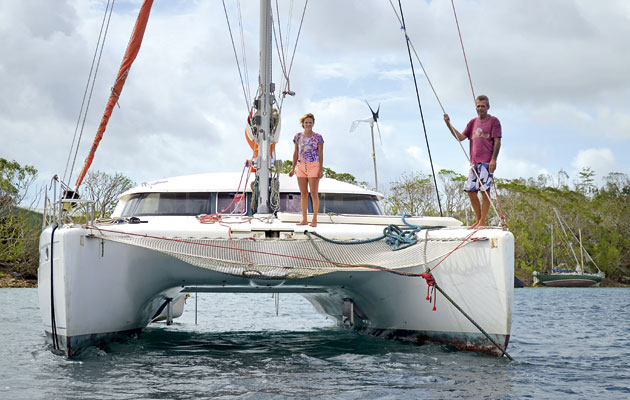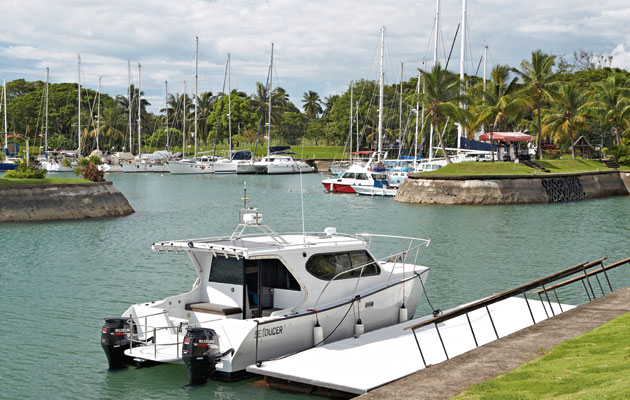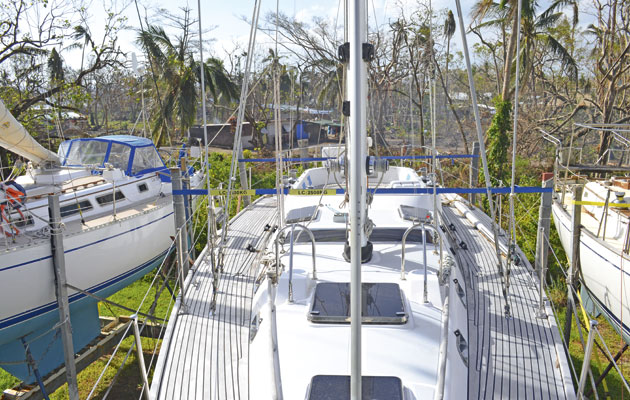Cyclone Pam wrecked dozens of yachts in Vanuatu. Tom Partridge returns to Port Vila to ask who survived, and how
What all sailors can learn from Cyclone Pam
Cyclone Pam ripped through the islands of Vanuatu in March 2015, causing almost unprecedented devastation. It was classified as Category 5: with maximum mean wind speeds over 108 knots. Port Vila recorded wind speeds of 116 knots gusting to 185 knots between 2200 on Friday 13th and 0200 on Saturday 14th as the eye passed to the east, with winds tracking from southeast to southwest. Vanuatu may be on the other side of the world, but even southern England has had winds of more than 100 knots in recent years, so there is much we can learn from the experience of those who rode out the storm, ashore or afloat.
‘A very scary night’
I spoke to several people who said they were ‘scared – very scared.’ Our friend Carine Morel-Boycene described it as ‘Like a jet’s engines screaming at full throttle, for four hours. I can’t believe we survived. I expected to find most of my friends dead.’
When news of Cyclone Pam broke, many images showed the destruction caused in Port Vila, often referred to as a ‘cyclone hole’. Shelter is good but in cyclone conditions it’s known locally as ‘the bowling alley,’ a reputation not helped by boats rushing in seeking shelter without the time to secure their mooring properly.
It’s estimated that there were over 50 boats on moorings in the harbour that night. Just over 20 survived – and several of those were motorboats that had been driven onto the beach deliberately.
Vanuatu devastated
There were 24 fatalities and it was the local Ni-Vanuatu who bore the brunt. The aftermath was shocking; entire buildings were flattened and a once lush country had been stripped of its greenery.
The Ni-Vanuatu are often described as the happiest people on earth, always laughing and smiling. They are also strikingly humble. I asked if they were OK, they replied ‘Yes, me OK.’ Your family? ‘Yes, they OK.’ And your house? ‘Fallen’ they reply softly, almost embarrassed.
Life here is still largely self-sufficient and villagers take their produce miles to big markets to sell. Now there are no crops, no food, no money and fresh water tanks were destroyed. For now, they need our support.
Yachting Community delivers emergency relief
With local delivery vessels either crippled or servicing larger populations, yachts are in a position to gather donations, buy aid and deliver supplies to isolated islands.
Aid organisations Sea Mercy and Oceanswatch are both sending fleets to Vanuatu, the World Cruising Club has raised funds from donors and is helping the islands of Efate and Tanna where the World ARC will visit in July. The Ocean Cruising Club has rallied its members to raise funds and sail to the islands with aid.
Private skippers are also lending their skills, whether building, electrical, medical or educational. Inspired by our time in Vanuatu, we too have raised funds, filled our forepeak with building tools and equipment, food and medical supplies to help the Ni-Vanuatu in need.
Far from being put off, many sailors have changed plans to include Vanuatu. Their help will make peoples’ lives better.
For more information or to donate, go to: www.yachtingmonthly.com/vanuatucyclone
Chaos on the moorings

Port Vila Harbour was like ‘a bowling alley’. Most boats moored in Paray Bay but fell victim to winds SE veering SW of 116kn, gusting 185kn
Regardless of how meticulous your own preparations are, your fate depends on all the boats upwind of you doing the same. Victor Nottleman, whose sailing yacht Ethereal survived on her mooring, watched from shore. ‘Boats were being swept down the harbour, colliding with other boats, taking out other mooring lines, with the result that more boats were swept down. It was horrible.’
Port Vila Harbour was like ‘a bowling alley’
Cristian Juillurmé and Rosio Ríos stayed aboard their catamaran, Marmajua, a 42ft Fontaine Pajot. With a week’s notice, they began their preparations. To keep her steady on her mooring, they secured two 38mm diameter lines from each stern to thick tree trunks onshore, spread at wide angles. They also ran a line from ashore under the boat to a shackle on their longeron (the beam that runs forward along the centreline) and then onto the mooring line to try and reduce fore-and-aft motion. Cristian dived the mooring to ensure the chain and shackles were in good condition. Finally, they minimised windage and set two anchors.
They prepared a grab bag and lifejackets. If they had to abandon, they would board the tender and pull themselves along the stern lines to shore.
‘Bowling alley’
Cristian and Rosio could only watch as other boats tore free from their moorings. First a sailing yacht hit their starboard bow and got caught on their mooring line. Cristian recalls, ‘It was stuck for about an hour, bouncing up and down as I tried to get it off.’ Next was a fishing boat that scarred their topsides.
Cristian and Rosio were in VHF radio contact with a neighbouring catamaran, Sanyasin, that also had crew aboard. They eased Sanyasin’s stern lines to escape a fishing boat that hit them. Soon Sanyasin was a metre off Marmajua’s starboard hull. Then Cristian saw the skipper cut his stern lines, launching the cat forward onto Marmajua’s bows, taking out the longeron, forward beam and forestay, before colliding with the port bow. Finally Sanyasin split in two, the father and daughter on one hull, the mother on the other. With 5m visibility they disappeared downwind. Cristian later learned that the family survived.
Cristian spent almost four hours protecting his boat in 1.5m waves. ‘Was I scared? No, I just wanted to protect my boat.’ Rosio confessed ‘This boat is our home and I was scared, very scared.’
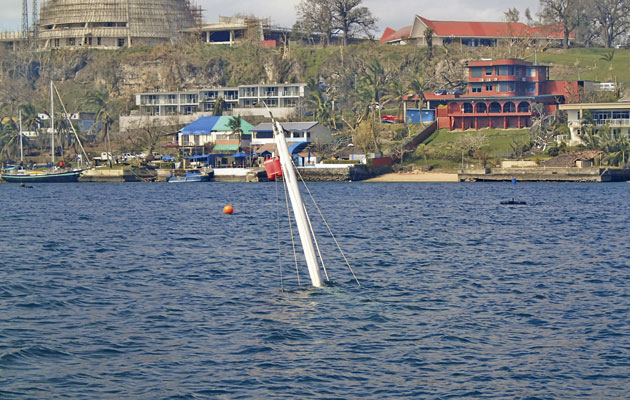
Geoff Brown spent two years restoring his Swan 431 Black Pearl. This is what he found the next morning
Geoff Brown, a New Zealander based in Port Vila, spent two years restoring his Swan 431, Black Pearl, launching her just before the cyclone season. He kept her afloat, on a cyclone mooring with two 38mm lines shackled to the chain and chafe protected at the bow rollers, but decided he wouldn’t stay aboard. The decision saved his life.
‘My boat was hit at least once, cutting her from the moorings and damaging both the hull and deck on the port side,’ said Geoff. ‘She was then trapped under other boats’ lines before rolling down, taking on water and sinking.’ Next morning, all Geoff could see of Black Pearl was her masthead, 100m from her mooring.
Protected in the boatyard
Less than half a mile away, Port Vila Boatyard, with around 35 boats inside, was undamaged. One of the key factors in its survival was its location, sited behind a 150m hill providing protection from southeasterly and southwesterly winds.
As part of our circumnavigation we wanted to experience life on a tropical island, so Susie and I decided to base our Hylas 46, Adina, in the boatyard for the cyclone season. In recent years, the tropics have become an increasingly popular choice as more is known about cyclones so forecasting is better, boats can be better protected and the facilities have been developed precisely to keep yachts safe in cyclones.
Port Vila Boatyard’s reputation as a cyclone hole is growing, but Vuda Marina in Fiji is renowned for its cyclone storage facilities. Adam Wade, general manager, says ‘We are fully booked by May, well ahead of the cyclone season.’
Belt-and-braces cradle
As we were researching our decision, we spoke to Justin Jenkin, owner of Port Vila Boatyard. ‘We have cradles made from structural steel I-beams which have four steel hinged arms held securely against the vessel’s hull. Eight sets of chains and turnbuckles secure the hinged arms and we use Acrow props.
These come up against the underwater part of the hull and are placed at right angles to the hull from the four outer corners of the cradle, then wound up tight to secure the hull.’ Crucially, we consulted with our insurer and, following due diligence on their part, they agreed to insure Adina on the hard in one of the boatyard’s secure cradles.
Reduce windage
We stripped Adina of any items that could cause windage as soon as she was out of the water so that she would be set for the cyclone season. There were insurer requirements such as removing sails, bimini, sprayhood and ensuring these were stored inside the boat. We went further, taking off everything we could, including MOB recovery kit and halyards. We sent photos to our insurer to find out if they thought we needed to do anything more but they said they were happy.
Susie and I were at a wedding in New Zealand when Pam hit. We felt helpless and feared for friends and the Ni-Vanuatu.
In the week leading up to the cyclone, the Port Vila Boatyard team worked hard as more boats were brought onto the hard standing. Their final preparation was to take lines from boats to underground anchor points around the yard.
Our friends, Frank and Dorte von dem Bottlenberg, had survived Fiji’s cyclone Evan aboard their Morgan 41 Elan while secured to a mooring buoy. Ashore in Port Vila, they took additional lines from the top of the mast and secured them to the ground. They had been living aboard in the boatyard but chose to seek the safety of a hotel for the night of the cyclone.
Anchoring as a last resort
Only one yacht is known to have remained at anchor as Pam passed over – a 50m superyacht called Blue Gold. She was further north in the sheltered area of Havannah Harbour where she had been at anchor for over two years. The crew deployed two anchors but Blue Gold ended up ashore on a nearby island.
Learning from Pam
There are lessons for all cruisers to learn from Cyclone Pam. While winds of this strength are still rare, weather patterns are becoming less stable so understanding how to prepare for these events is critical. It has been proven both through Pam in Vanuatu and Cyclone Evan in Fiji, that if yachts are properly prepared and in the right location, they can withstand winds of hugely destructive force.
Digging in ashore
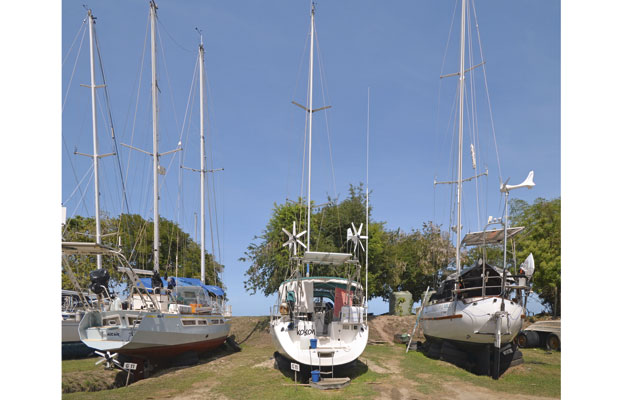
The manager of legendary cyclone hole Vuda Marina, Fiji, says digging in the keel is the best way to ride out high winds
Vuda Marina in Fiji, with its uniquely designed marina and land-based facilities, is widely regarded as one of safest cyclone holes in the Pacific and it survived Cyclone Evan, with wind speeds of 120 knots, largely unscathed. Marina general manager Adam Wade believes that the safest option is a hole in the ground in which a yacht’s keel sits, with the hull supported by rubber tyres. Second to that is placing the boat in a well-made, well-secured cradle on the hard. Third choice would be a sheltered marina, with a cyclone-proof mooring his fourth choice, and anchoring very much a last resort.
We felt Adina was as secure as we could make her. She was tied to her bombproof cradle using ratchet straps from bow and stern, port and starboard, and two more across the decks to the legs of the cradle; each with a breaking load of 2,500kg. Deck up, she was stripped bare. In hindsight, we should have removed our vang and lowered the boom to the deck to reduce windage. It’s a big job to remove your mast and we didn’t have the facilities to do it, but if you can it is a good idea.
Standardise moorings
‘All remaining moorings in Port Vila need to be inspected by qualified experts before use,’ said Peter Wederell, owner of local business Total Marine Solutions. ‘Any new moorings put in to replace missing or damaged moorings must be built to a specified standard, and regular inspections by qualified experts need to be legislated and enforced.
Don’t stay aboard
Cristian dived to check the mooring for his Fontaine Pajot 42 catamaran Marmajua and found thick chain and solid shackles. He secured her well in every direction, tying her to shore from her leeward mooring using 38mm lines with plenty of contingency. That withstood the constant wave surges and resisted the chafing that resulted in others parting their moorings. However, her mooring at the business end of the ‘bowling alley’ meant boats were blown down onto her. Would Cristian do anything differently next time? ‘I feel I protected Marmajua as best as I could,’ he said, ‘but next time I would not stay on the boat.’ Cristian is working hard to repair the damage and will sail on.
Strong winds are inevitable
On Black Pearl, Geoff used two 38mm lines with hosepipe chafe protection at the bow roller and reduced windage as much as he could, but her mooring parted and she foundered. What would he do differently? ‘Possibly I would haul the boat during the cyclone season, though it can be the best time to cruise these beautiful islands,’ he said. ‘Another choice would be a less congested mooring site.’ Geoff faces a huge restoration job and, having decided to play safe and stay ashore, he will never know exactly what happened to Black Pearl, but he knows that paradise has its price: ‘In tropical climates we must accept the cyclone threat. I still love Vanuatu.’

Tom Partridge and Susie Plume relaunched Adina, their Hylas 46, and delivered aid to outlying islands
These islands will recover. Lessons will be learned. New rules will be implemented, and next time they will be better prepared, whether ashore or afloat. It‘s still a wonderful place to sail, and Vanuatu deserves its place on the list of ‘must-see’ Pacific destinations. Blue water cruisers love adventure and it abounds in these beautiful islands.
Read Tom’s 20 top tips for surviving strong winds







